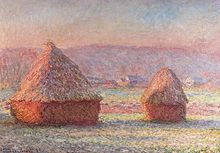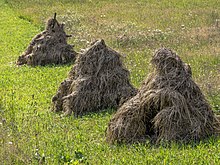Dieme

A Dieme (also Docke , Feime , Triste , regionally also Diemen (mask.), Hocke , Höcke or Hock , Doll , Hauste , with scaffolding Heubock , Heinze , with roof Schober ) is a regularly put on pile of in traditional agriculture without machines Hay , straw or grain that is planted in the field when it is harvested. The grain stacks are placed side by side so that the ears of wheat form the highest point and can then dry out.
Name forms
The names vary according to the landscape. The term Dieme is unknown in Saxony and Thuringia . There the term "doll" is used. In their German dictionary, the Brothers Grimm explain puppets: “Sheaves that are upright in the field and with their ears turned upwards (10 or 15); dolls are placed in wet summers or to allow the not fully ripe sheaves to ripen (in Thuringia, Upper Saxony, Lusatia) ”.
history
Diemen have been known since the Iron Age . The grain was mowed, tied into sheaves by hand and these sheaves were then set up in diemen. So the grain dried on the stalk. When the grain was dry, it was threshed : Before the invention of the threshing machine, it was driven into the barn and mostly threshed with flails in winter. Later you thrashed in the field, provided that the field could be driven over with the threshing machine; In the marshland and moorland areas the diemen were dissolved again and the grain stacks loaded onto a cart with a fork and brought to the yard, where it was threshed mechanically.
The diemen were erected either directly on the ground or on iron and wooden frames, the latter with stone plinths. They could taper to a point or expand upwards.
The North West German and Dutch Heufeimen or rods mountains were piled between upright poles with ascending and abschiebbarem roof.
Grain and fodder were usually built on a base of straw or on racks and covered with straw on top, even after the weather side was specially stored.
In England , iron frames were used almost exclusively.
If the supplies were stored on the ground, the whole thing was surrounded by a deep trench with steep walls, and holes or pots were made in it to catch the mice. Grain had to be carefully stratified with the ears inward; In England, special machines were used to wind up the sheaves (elevators).
The fruits kept at least as well in well-layered and protected diems as in barns . Where fodder and straw were regularly layered on fixed scaffolding in a special farmyard, a roof was also installed so that the rain was kept out but the air could freely pass through.
Schober
A similar form of storage are racks , which also have a light roof. Rents were built for the storage of crops .
Hay rider
Heureiter (Reuter) are wooden racks on which freshly cut, dried grass was hung to dry completely before the advent of machine-assisted agriculture . They were mainly used in prolonged damp weather conditions, when drying hay on the ground was impossible or difficult. The racks are set up in the fields . The damp grass is stacked on top of them in such a way that the layers overlap, similar to roof tiles. Today they are generally rarely seen in the fields.
Heinzen
Heinzen were used to dry hay in the Alpine and foothills of the Alps . The name is usually changed to Huanza or Hoinze in dialect . In the North Tyrolean Unterland they are known under the name Stanker or Stangger , in the South Tyrolean Pustertal as Stiffla (Stiefler).
Tiroler Heinzen are frames that consist of a 1.5 m long post that is driven into the ground, and usually three wooden cross rungs, called "Heinzenschwingen", on which the grass is hung.
Heumanderl
A simple form of the Heumanderl is created by tying three wooden poles together in the form of an Indian tipi and setting them up. In order to ensure better durability of the moist grass, these three poles are also equipped with cross bars. There is also a distinction between Steinacher Hütten , which are frames on four posts with cross braces that are stretched like a tent, and Scherzinger Heinzen (also known as Dreibockreuter , Heumanderl or Heumännchen , but locally also called Heinzen), i.e. frames made of three poles that can be folded up are. The word Manderl stands for little man , so the Heumanderl are usually under "man size", which distinguishes them from the Heureiter. Some replicas are marketed for decoration. They serve as a piece of jewelery in the suburban garden or serve as a misappropriated hanging device for garden utensils such as watering cans, buckets or garden hoses.
Sweden rider
Another, similar option for drying cuttings is so-called Schwedenreiter . In this construction, wires are stretched between wooden posts on which the grass is then hung.
The structures are not roofed over, but ensure that the hay cannot absorb soil moisture and is not completely exposed to the rain. The grass, which is suspended like a roof tile, creates a stratification in all types, which means that the water drips off on the outside and only penetrates a little inwards.
Dry scaffolding with horizontal wooden poles exist in the Alpine region. They are called histe or harp and in Slovenia they are called Kozolec .
Clover udders are used for drying clover.
Schober and Diemen in the fine arts
Grain stacks (French: meules , Catalan: pallers ) were popular with painters who chose motifs from the agricultural sector. In addition to Claude Monet , who painted a whole series about it, these include Jean-François Millet , Camille Pissarro and Vincent van Gogh . Similar traditions existed in the Catalan landscape painting school of Olot .
In the winter months of 1890/1891 Claude Monet made hay and grain stacks in various light and weather moods as his artistic subject in the vicinity of Giverny . After the harvest, the farmers there had placed countless hay and grain stacks on the fields bordering on his private property to the west and facing the Seine. Monet has artistically studied these visible signs of rural livelihood in series of pictures since the 1880s. He questioned the previous approaches of Impressionist landscape painting and researched aspects of color, blurring and mood in landscape objects with these works.
The Catalan painter Joan Clapera i Mayà , who was in the tradition of the Olot School , created numerous haystack-themed works in the second half of the 20th century. In this regard, he continued Monet's work in an abstract, initially expressionist, and in his late artistic phase then surrealist.
literature
- Der Neue Herder, Volume 1, A - L, Column 1076, Freiburg im Breisgau (Herder) 1949, article “Feime”, there also the regional synonyms “Barmen”, “Diemen”, “Feimen”, “Feim”, “Rent "," Schober "," Triste "and the definition:" Pile of grain carefully placed outdoors [...], hay, straw, covered against rain with straw or a waterproof blanket "
- Wolf Haio Zimmermann : Harvesting in Rutenberg and Diemen from an archaeological and ethnological point of view. In: Néprajzi értesítő. Vol. 71/73, 1989/1991, ISSN 0077-6599 , pp. 71-104, digital version (PDF; 2 MB) .
- Siegfried Laferton: Heinzen: Hay drying racks accompanied the development of Allgäu grassland management . Swabian Farm Museum , Illerbeuren 1992, ISBN 3-9802236-3-9 .
See also
Web links
Individual evidence
- ↑ Konrad Schwenck: Dictionary of the German language in relation to descent and concept formation. JD Sauerländer, 1838, page 297; limited preview in Google Book search.
- ↑ Christian Wenig: Concise dictionary of the German language. DuMont-Schauberg, 1876, page 365; limited preview in Google Book search.
- ↑ Brothers Grimm: German Dictionary, para. 5 c To doll, vol. 13, col. 2246 ( link to the digitized version at Woerterbuchnetz.de )
- ↑ Zimmermann 1991, p. 79 ff.
- ↑ http://www.hofinger.eu/wikih/Sprachstrich,_quer_durch_Schwaz_oder:_Es_gibt_kein_Tirolerisch
- ^ Community journal Gais im Pustertal 2011, No. 1, p. 68
- ↑ https://www.youtube.com/watch?v=CSwmfZQyT4I
- ↑ http://www.badische-zeitung.de/loeffingen/zu-was-ein-heinzen-gut-ist--32133308.html
- ↑ Robert Gordon, Andrew Forge: Monet. DuMont, Cologne 1985, ISBN 3-7701-1568-6 , p. 158.
- ↑ Alexandra Matzner: Auction world record for Monet's "Haystack". November 17, 2016, archived from the original on November 22, 2018 ; accessed on July 4, 2020 .










